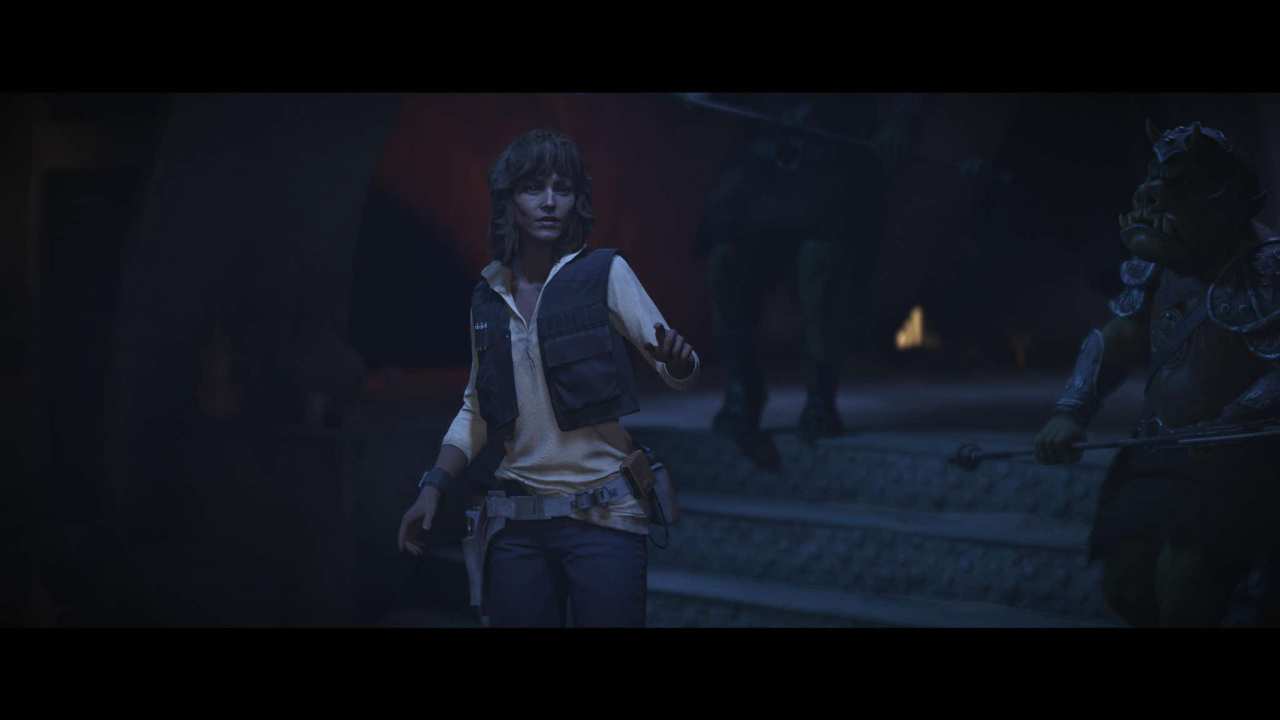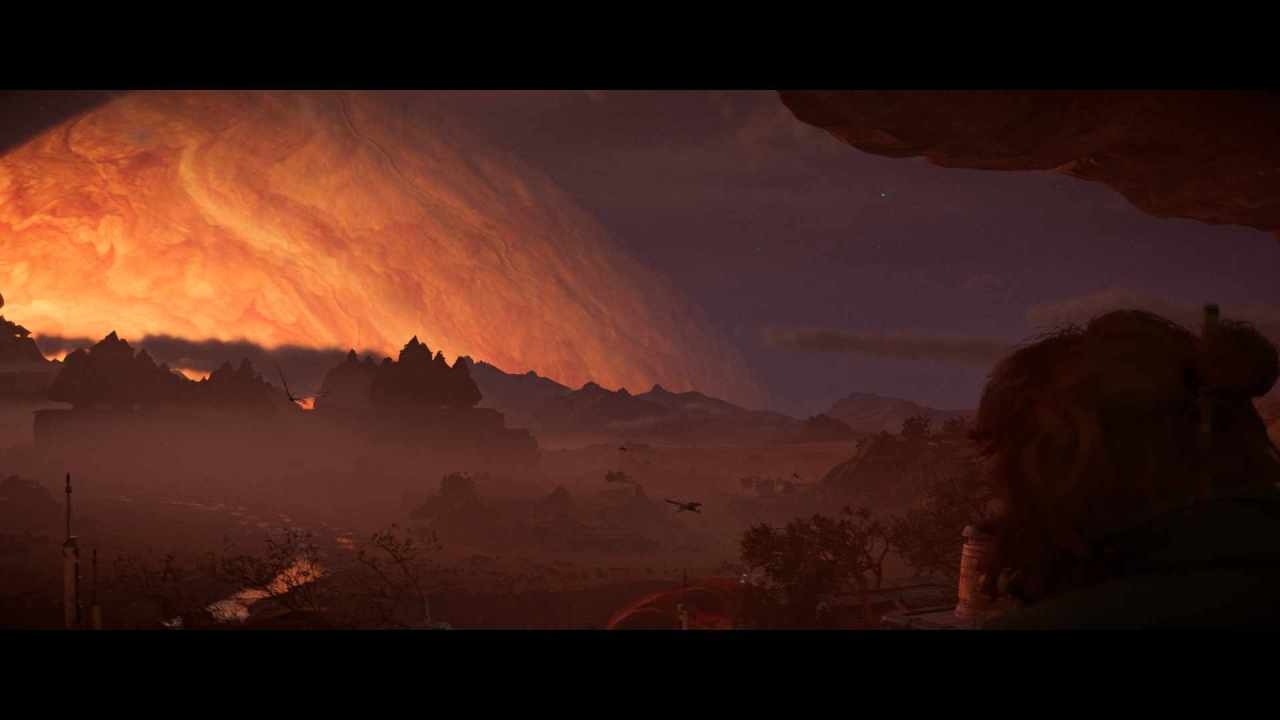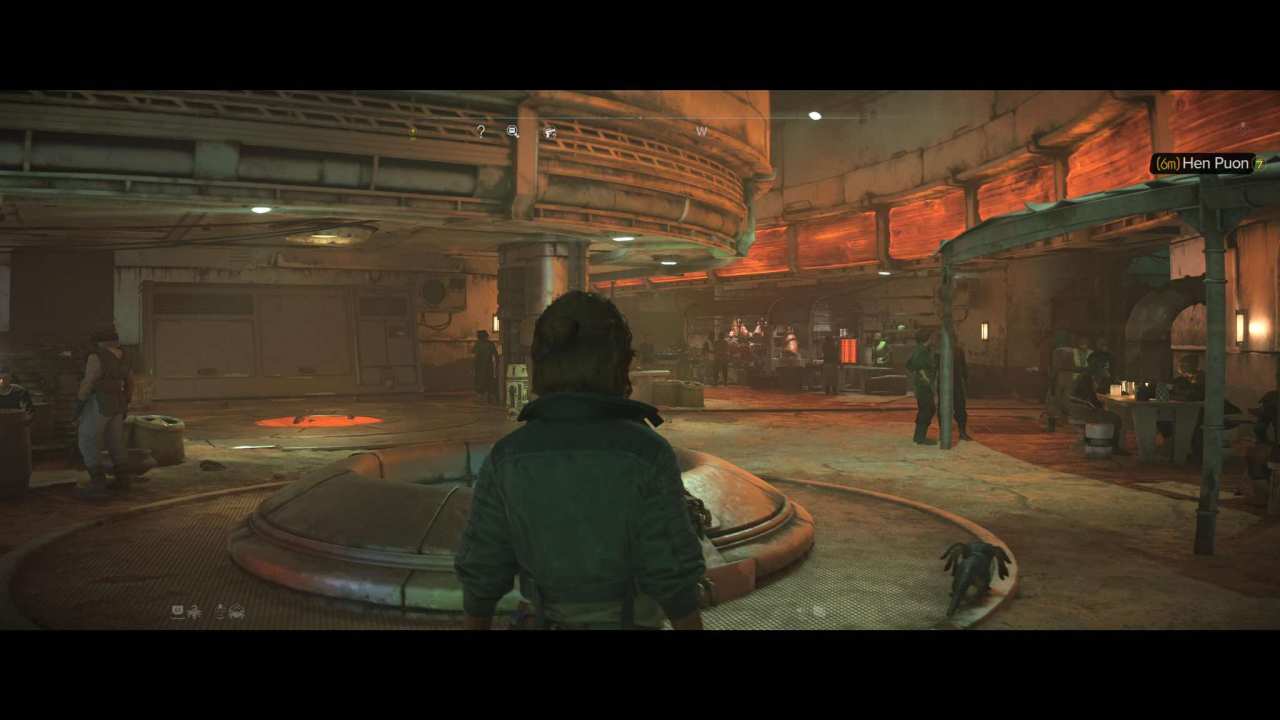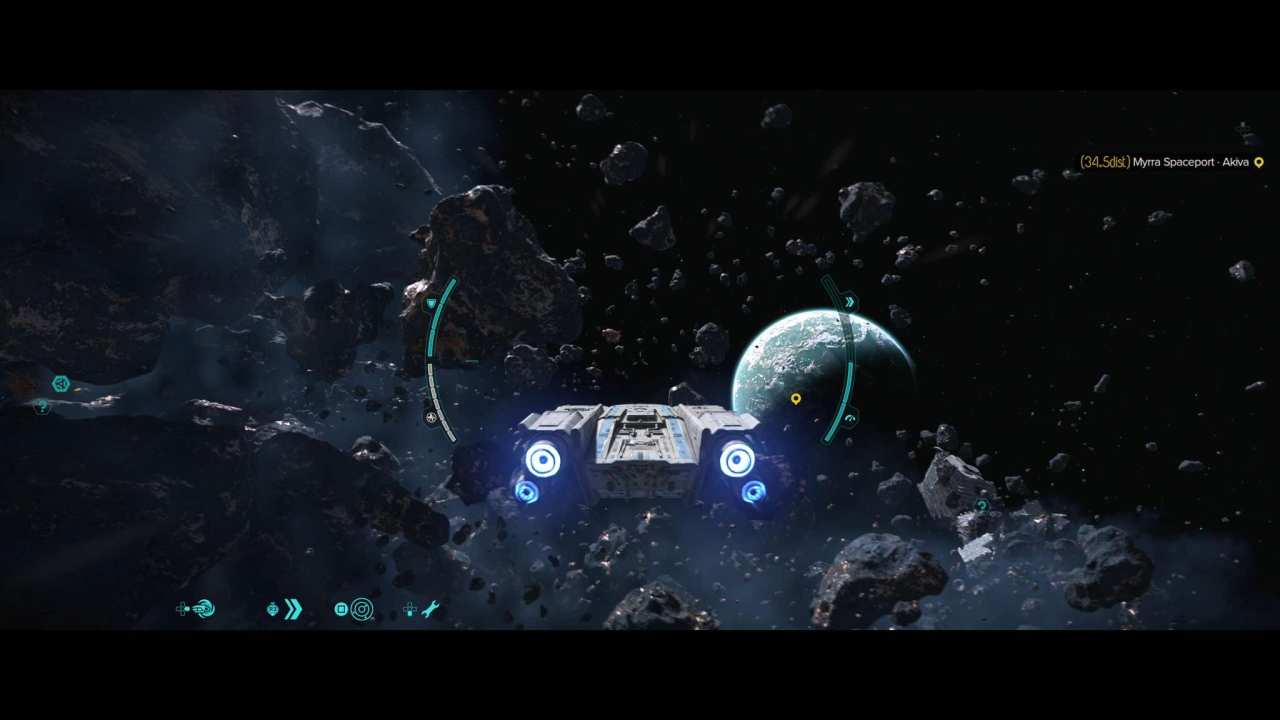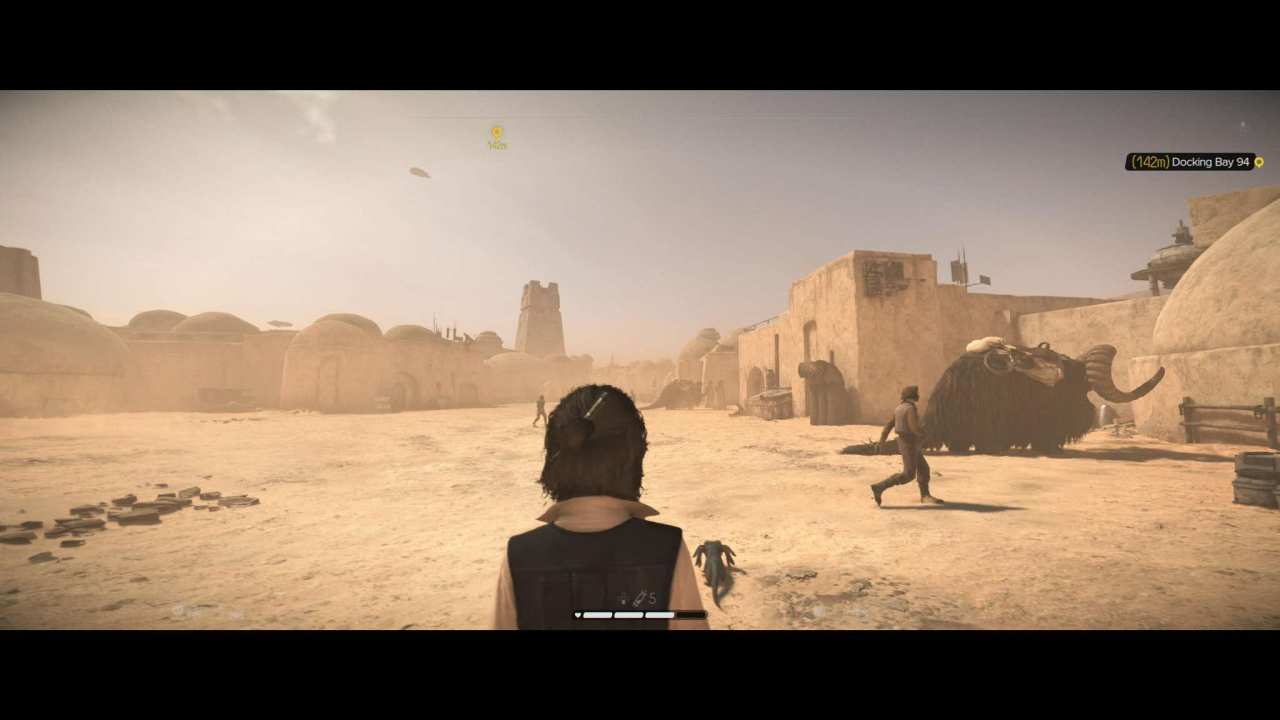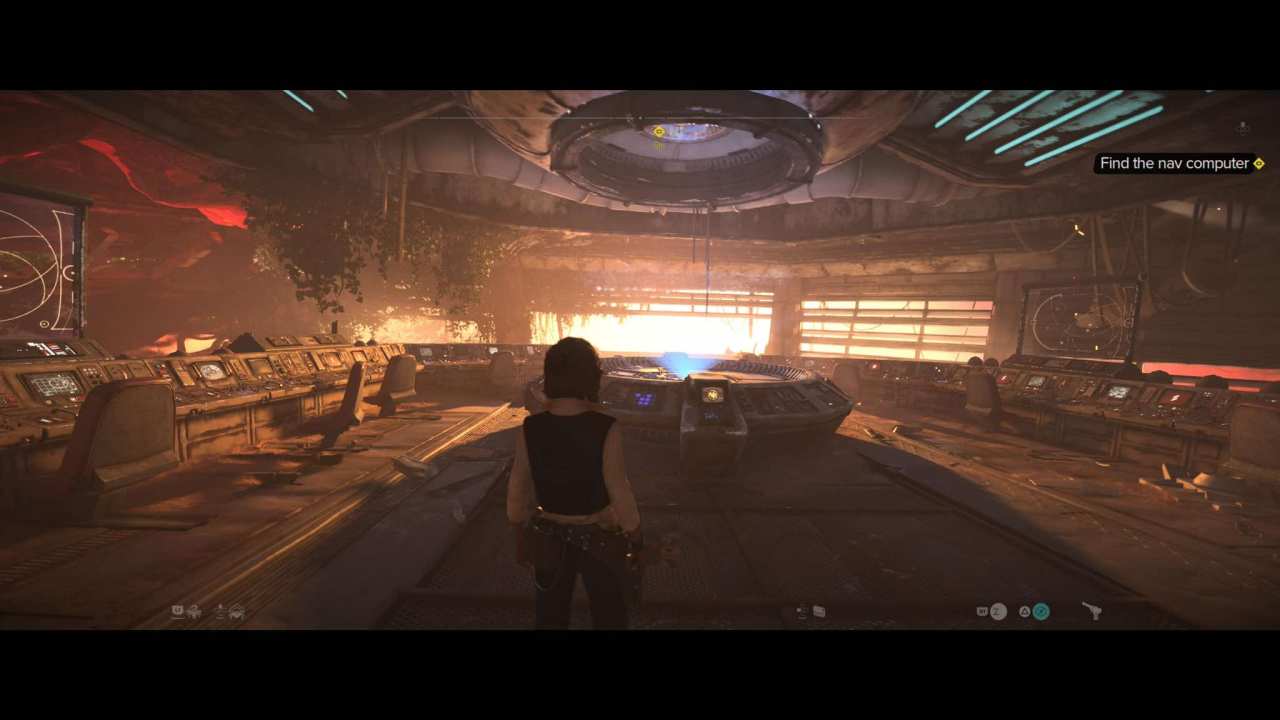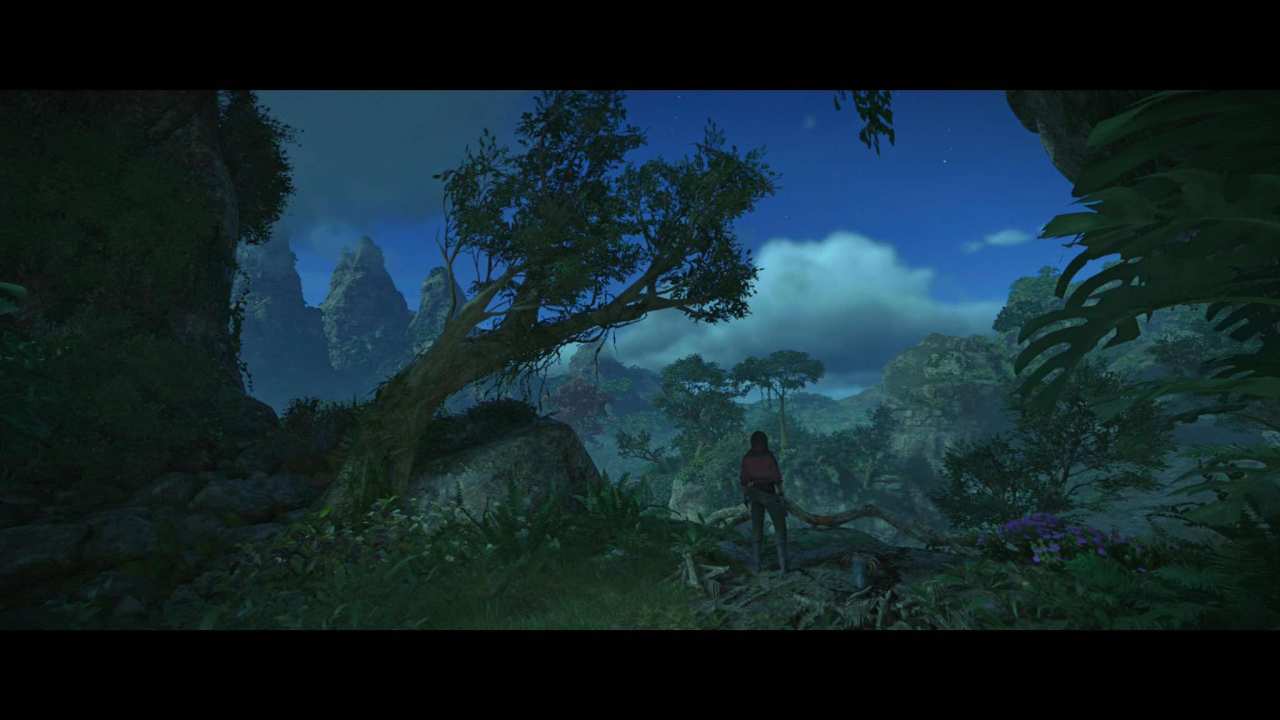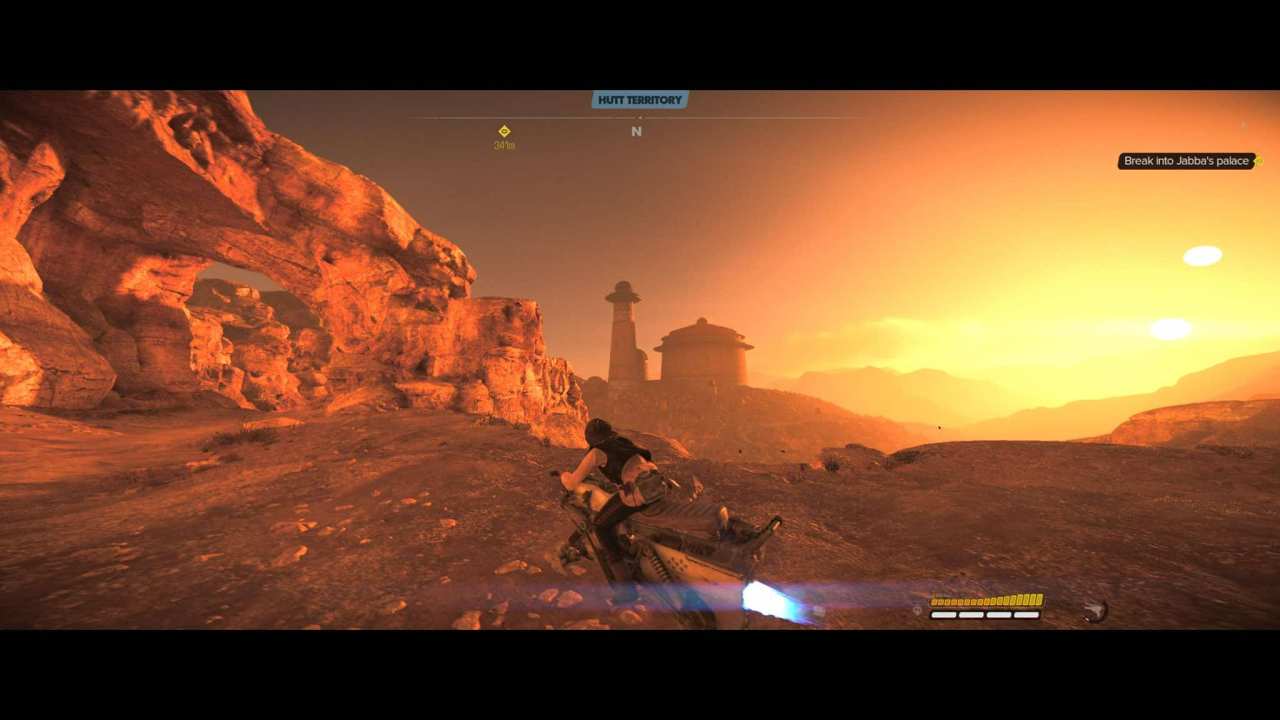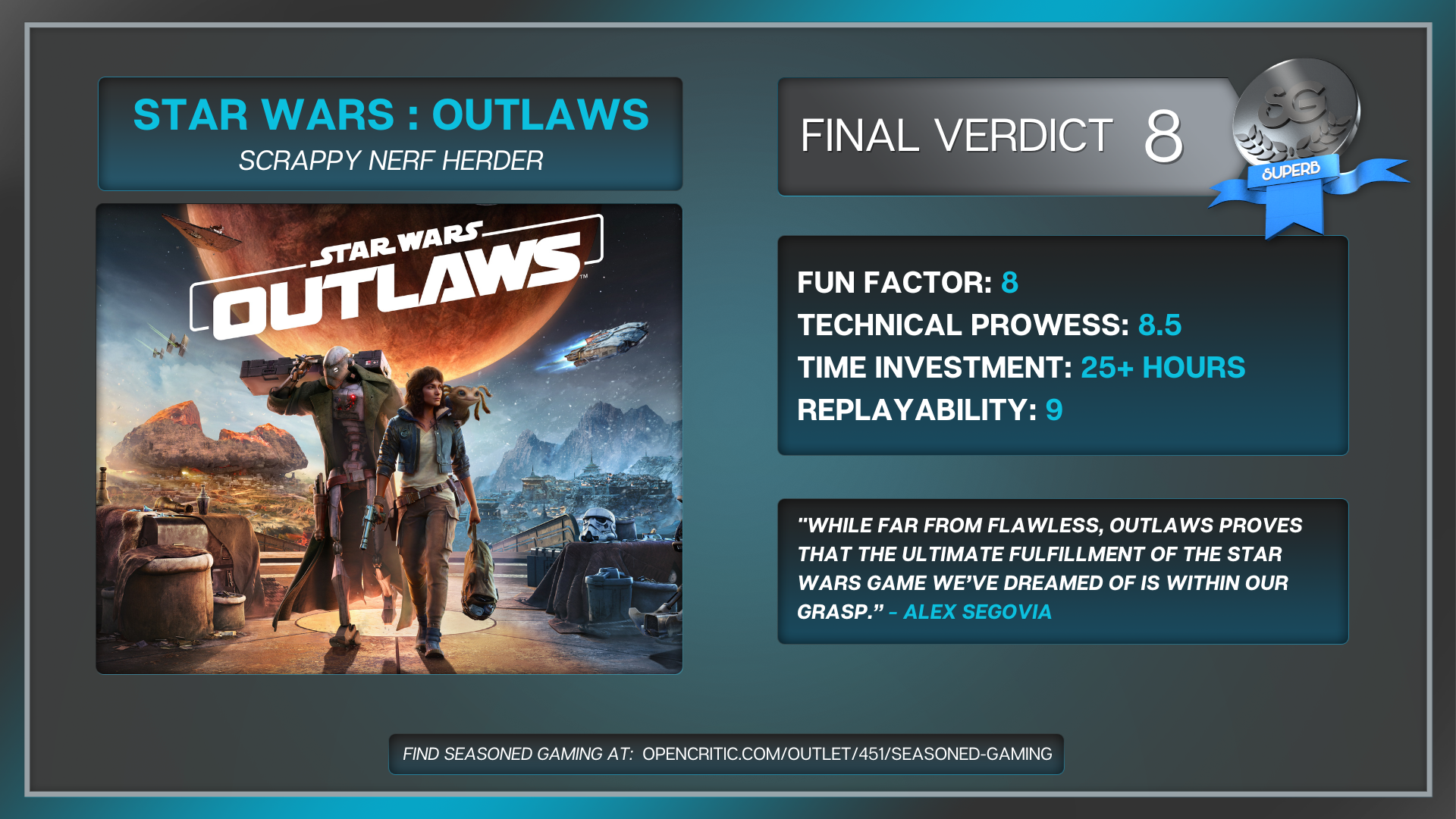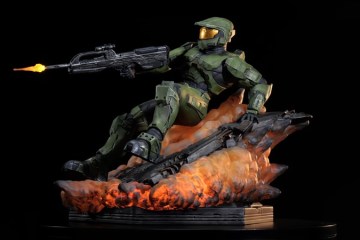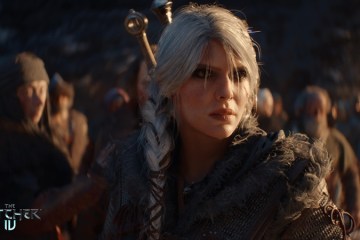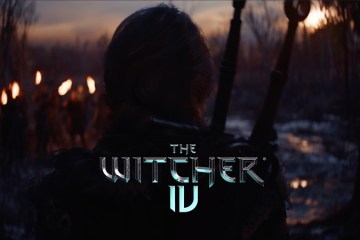For as long as Star Wars has existed as a franchise, and for as long as gaming adaptations have been a thing, I’ve only had one dream: an open world game set in a galaxy far, far away.
Considering how pervasive the open world genre has been over the last decade in gaming, one would have thought we would have gotten one of these games set in the Star Wars universe by now. But even during the franchise’s gaming heyday, a seamless open world game has eluded us like the Millenium Falcon completing the Kessel run in 12 parsecs. But now, just one year after the 10-year exclusivity contract with Electronic Arts ended, here comes Star Wars: Outlaws by way of Ubisoft and Massive Entertainment. And now, after years of endless suffering and endless dreams, have they finally delivered to us what we’ve been looking for?
Short answer: yes…from a certain point of view.
A Death Mark’s Not an Easy Thing to Live With
Set in the year between The Empire Strikes Back and Return of the Jedi, Star Wars: Outlaws puts you in the shoes of Kay Vess, a down on her luck scoundrel from Canto Bight trying to live her life in the shadow of the galaxy’s seedy underbelly. After a score gone wrong puts her in the eyes of crime syndicate Zerek Besh and an insurmountable Death Mark bounty, Kay and her alien pet companion Nix are forced to go on the run, evading fellow bounty hunters and joining forces with other scoundrels, where the promise of one final score and a new life of freedom could be the answer to all that ails her, even if it means putting herself in the crosshairs of the most wretched hive of scum and villainy in the galaxy.
Part heist caper/part Oceans 11, the story of Star Wars: Outlaws is mostly a simple tale of gathering a team that will help Kay get out of her deadly predicament as she travels to four different planets on her pursuit of the ideal companions for this one final score. Compared to the most recent Star Wars game in the market, Star Wars: Jedi Survivor, which was a more pensive, character driven tale about the nature of living life as a gray Jedi, Star Wars: Outlaws definitely adopts the scrappier, more jovial tone of the franchise’s beloved original trilogy. It’s a bit more low stakes/high adventure than the franchise has offered in recent years, which may irk some that seek more depth out of their Star Wars stories, but it will be welcome for those that want something simpler and more fun from these grand space operas. The fact that the story can cross over with known characters from this era of the saga without becoming just a blatant “member berry” nostalgia play is certainly a plus.
While initially giving “Han Solo” vibes with a side of YA, Kay Vess manages to mostly sidestep that typecast to become one of the more likable heroines I’ve seen in the Disney era of Star Wars. Her down on her luck scrappy nature keeps the character grounded amongst her interactions with the more serious crime underbelly, and her relationship with Nix definitely provides most of the story’s emotional resonance. The rest of the cast she meets up is mostly solid, with the robot companion ND-5 being a personal favorite of mine with how he represents a great marriage of both the prequel and original trilogy eras and the gravitas that entails.
You Will Never Find a More Wretched Hive of Scum and Villainy
The big question mark surrounding Star Wars: Outlaws is simple: does it deliver on the dream of a seamless open world Star Wars experience? For the most part, developer Massive Entertainment delivers on that dream on a grand scale and with indelible set dressing. Being able to traverse the wild savannas of new planet Toshara, lurk in the corners of the frozen wasteland of Kijimi, and roam the vast deserts of Tatooine delivers on the grandiosity of wanting to live in this galaxy far, far away. With Ubisoft being well known for their expertise in perfectly recreating environments since their work on the original Assassin’s Creed, how Ubisoft has perfectly recreated a play space like Tatooine and most of its famous locations from the movies is commendable to their environmental artists. After almost 30 years of wanting to just exist in some of these worlds, Massive deserves major kudos for delivering on the childlike wonder of nailing some of these places.
But an open world game is more than just its set dressing. When it comes to interacting with the worlds in Star Wars: Outlaws, things are a little bit more familiar if you have played one of Ubisoft’s open world games before. How they approached Star Wars: Outlaws from a design perspective shows some of the way they’ve evolved their formula a little bit. For a studio that has received some well deserved grief over the overly bloaty nature of their open worlds and their busy UI’s, Massive has done great strides both with last year’s Avatar: Frontiers of Pandora and now with Star Wars: Outlaws at streamlining how they present the basic readability of their UI and how overly busy the play spaces really are. While, eventually, I had way more side activities available than I dare admit, the way you can acquire said activities felt more diegetic and natural than usual and less “checklist to be checked” than what has plagued previous Ubisoft open worlds. Massive took great strides at providing a clean presentation to their play spaces, and that led to the world feeling less bloated despite the high number of side quests, bandit camps, space ship contracts, Sabbac card games, and racing mini games available.
Amongst all these activities, I have to give special mention to all the times you could go into space. Star Wars: Outlaws really comes alive as a game the moment you are able to board your ship and go into space. While it’s clear the transition between land into the skies is a well elaborated loading screen, it’s presented in such a way that it sells you in the immersion of the world Massive Entertainment has created. Add to that the visceral speed and nature of the way some of the space dog-fighting can unfold when you engage with it, and it becomes the extra flavor element that sells you on the fantasy of living in this big Star Wars galaxy.
Alongside its plethora of main and side missions, one big string that permeates the entire experience is the Reputation system amongst the four different crime syndicates that can dictate the way the world interacts around you. During most of the missions, you’ll sometimes be presented with some tough choices that determine which faction you want to align yourself more with, which can have some pretty big consequences on some rewards you get, and even just the basic navigation of some worlds. A low reputation with the crime syndicates can prove pretty deadly even to basic exploration at times if you stumble upon their territory in your explorations. It’s a system that brings to mind something Ubisoft applied all the way back in 2006 with Splinter Cell: Double Agent, and it’s a system that is at its strongest early on when some of your choices feel very consequential. Unfortunately, the system becomes so easily exploitable and loses its luster as soon as you have access to “Contract Brokers.” The contracts you get provide very simple fetchy side-quests that can easily fill up the reputation of the syndicates, taking away a bit of the impact of making a tough choice early on when you have such an easy tool to improve your standings with all four. If you want to keep the game interesting, I recommend skipping the contract and living with the consequences of your choices.
(S)he is as Clumsy as (S)he is Stupid
Ironically, where Star Wars: Outlaws does stumble a bit is in very specific elements of its gameplay design. For the most part, Outlaws is a third person shooter with lots of climbing around and a heavy emphasis on stealth. If you were side-eying it, you wouldn’t be mistaken into thinking you are looking at an Uncharted-style game with the general flow of movement and combat (giving you a bit of a taste of the canceled Star Wars 1313 and Project Ragtag games we never got). From a basic playability perspective, Outlaws can be pretty fun with some of the scrappiness of the shootout scenarios and some high-stakes stealth sections. But said exciting scenarios come more from its linear, curated main and side missions than they do in the open world.
Star Wars: Outlaws is a game that is very weirdly at odds with itself, where the gap in quality of what you see in the main missions basically falls apart when the game is at its most emergent and wide open. It’s to the point where, at times, it feels like a fairly linear Uncharted-style experience has basically been stretched to one of Ubisoft’s open worlds. And in the early goings where the game is at its most mechanically limited, this takes the shine away from the dream of the open world Star Wars game when the basic act of playing can feel so limited in such a grand game.
Simply put, Star Wars: Outlaws is a way more authored experience than an open world that emphasizes unique player expression. During the majority of play, Kay only has her one blaster with her with no option of a second weapon unless it randomly becomes available to be picked up during combat (which happens so randomly, there seems to be no rime or reason as to why you killed two random stormtroopers with the exact same weapons, yet you can only pick it up from one of them), and no way to keep those weapons with you at all times. Kay also has her trusty binoculars to help with the classic enemy tagging, as well as some classic and smoke grenades. Kay can also use Nix to fetch some items from across the world and help with distraction and attacks on some enemies as she slinks around. When that’s all you have at first, where it works well in the specific play spaces of the main missions, it can feel pretty dire when it starts setting in how limited her tools can be in the face of the grand open world adventure waiting for you.
Eventually, you get access to ability and weapon upgrades that start adding a bit more variety to what you have so as to not feel pretty threadbare. While Kay still only keeps her one blaster, you then get other blasting modes, like its zapper and power shot, which can add some variety to the gunplay (as well as other shooting modes for your blaster that you pick and choose based on your preferred playstyle). Some outfit gear you get sometimes come with specific perks that can help you kit Kay in a very specific way more tailored to your gameplay styles. Other upgrades you can get include improvements to Kay’s Adrenaline Rush (think her version of Red Dead Redemption’s “Dead Eye” system), and to other elements, like speeder and ship upgrades, movement speed, and improved stealth takedowns.
I have to give special mention to the stealth, because I was not fully aware just how heavily it would be emphasized in most of its gameplay scenarios, and just how inconsistent it can be with its rules from moment to moment. During the main missions, with proper curation the enemy placement feels logical with a proper pathway for a clean stealth run that can be pretty satisfying if you are able to figure out your pathway. But sometimes in the main missions, and especially often in the open world, enemy place and pathing is pretty odd, and their vision cones are wildly inconsistent where sometimes you’ll be noticed despite being perfectly in cover or in a hiding spot. It reminds me heavily of the inconsistent stealth that plagued previous Ubisoft games like Assassin’s Creed: Valhalla and even last year’s Avatar: Frontiers of Pandora.
To call a spade a spade, I’d say it’s a step above those mentioned games, but it’s still present enough to be noticeable. Considering how much stealth is baked into so much of the design in many of Ubisoft’s open worlds, it’s more notable when one suffers from inconsistencies, considering how many scenarios are predicated on you not being seen and sounding alarms. Now, to be fair, it’s not like these problems happen 100% all the time, but they happen with slightly more frequency than you’d like. It just leads to an experience that is very scrappy, which can be seen as fitting to a character as clumsy as Kay, but that clumsiness can sometimes hurt the gameplay experience.
A final quibble to mention, also from the gameplay department, is the inconsistent navigation you’ll find in a few of these open worlds. For the most part, traveling through these worlds can be a joy as you follow specific interest points and you lose yourself to the exploration of these beautiful locales. However, as soon as you need to do more verticality, the rules of what is climbable and what isn’t is wildly inconsistent, even from places that should be easily climbable (and, at times, a short rock formation would allow you easy climbing, but then that same rock will just not let you climb it another time). Worlds that are more narrow and close together suffer less of these problems, but when you are in the savanna of Toshara and you keep sliding down environments, it hurts the joy of living in such exotic, beautiful locales.
A lot of this is worth mentioning because, despite the nagging design flaws that threaten to derail it, for the most part the actual act of playing Star Wars: Outlaws can be quite a joy. When you seamlessly set yourself to explore these worlds, ride your speeder through the biomes, run into crime syndicates in the wild, run afoul of the empire at a high wanted level to have deadly death troopers on your tail, and find interest points that then take you out to the seamless deep space for the joyful spaceship sections, the dream of what this game can be is so loud and clear. It is what makes the design limitations of what it doesn’t do, along with the quibbles of its stealth design and world navigation, stand out that much more. When everything is clicking into place, especially in the curated missions that are some of the best that I’ve seen from a Ubisoft game in recent years, the frustrations, while not disappearing completely, kind of fade into the background of when everything else is hitting right.
“You’re a Jittery Little Thing, Aren’t You?”
Look at Star Wars: Outlaws at a glance, and it’s a mighty beautiful-looking game. Some of the artistry that brought to life many of these worlds are at a new level for Ubisoft’s Snowdrop engine, with a wide variety of colorful skyboxes that will give your screenshot button a galactic work out. As a big fan that grew up on the original trilogy, even as played out as the environment has become in other Star Wars transmedia, I had a mesmerizing reaction going through the world of Tatooine and visiting all these places I’ve known for so long, and the game’s beautiful presentation finally presented the living experience I’ve always wanted from a Star Wars game. Even with not having the same affinity to other places, like the casino of Canto Bight and the frozen fortresses of Kijimi, that same level of detail still made an impression. Massive did a great job of using Star Wars’ sonoric identity to a great authentic degree, even if the original music they composed didn’t stand out to me like I’m used to from the franchise’s legendary compositions by John Williams.
It wouldn’t be a Ubisoft game without extensive discussions about its technical chops, performance, and stability, and in that case, Star Wars: Outlaws, on its PlayStation 5 version, lands somewhere in between being a fairly stable release and having some technical, visual, and design quirks that can spoil the fun. From a general stability perspective, over the 26 hours it took me to finish it, I had one random softlock while interacting with a computer that I solved with a checkpoint reloading, and I also had one full crash. From a general performance perspective, the game performed pretty solid, both in its graphics and performance mode, with the only visual quirks appearing in some weird image dithering in the performance mode and slight dips during heavy shootouts. Jittery animations during stealth sections and sometimes getting stuck in geometry added a bit to an unpolished feel that doesn’t match the quality of the presentation at hand.
Like some of the design quibbles mentioned earlier, they are here and detract from the experience, but the overall quality of everything around it still sands off some of these rough edges. Compared to the technical state that last year’s Star Wars: Jedi Survivor launched in, Star Wars: Outlaws is a better looking and more technically polished game in comparison. (Word of advice to PC owners: seems like that version is rough in the pre-release state, so keep an eye out on technical reviews of that version. These tech impressions are for the PlayStation 5 version)
May The Force Be With You
Like a ship that makes a solid landing despite some parts hanging out of the seams, there are a few things that could have easily derailed the joyful experience that was Star Wars: Outlaws. Yet, like the scrappiness of its main protagonist, even when a few things get out of hand, it ultimately pulls through. Ubisoft and Massive Entertainment were the right developers to attempt this kind of Star Wars game after a decade plus of failed attempts and many other projects were lost. While far from flawless, Outlaws proves that the ultimate fulfillment of the Star Wars game we’ve dreamed of is within our grasp.
You can find Seasoned Gaming’s review policy here

